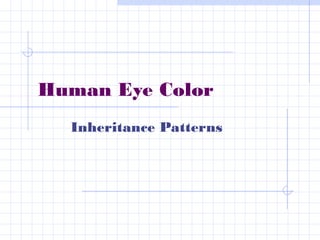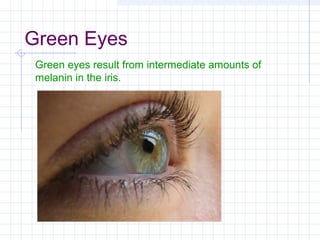Human eye color inheritance, Mr. Wright
- 1. Human Eye Color Inheritance Patterns
- 2. Eyes Eye color is controlled by at least three genes (three are known).
- 3. The Cause of Eye Color There are two types of melanin protein found in the iris of eyes; yellow and black. In combination, these proteins combine to yield eye color ranging from dark brown to blue.
- 4. Blue Eyes A lack of melanin in the iris is pure blue eyes.
- 5. Green Eyes Green eyes result from intermediate amounts of melanin in the iris.
- 6. Brown Eyes A lot of melanin in the iris makes brown eyes.
- 7. Hazel Eyes Hazel is an umbrella term for mixed eyes. They have both green and brown areas, in any mixture.
- 8. No Melanine (Albino) A complete lack of melanin in the iris is albino, and the iris appears pink due to the blood beneath the surface.
- 9. One Gene, Two Alleles BB Bb Bb bb B b B b At times, we treated eye color as simple dominance. Of course, if this were true, about 25% of humans would have blue eyes and there would be no green eyes.
- 10. One Gene, multiple alleles BB Bb Bb bb B b B b BB Bb BG Gb B G B b If eye color were controlled by multiple alleles, we might find three eye colors, but there would be little variation in shading, and no hazel eyes.
- 11. Polygenic, Multiple alleles and incomplete dominance! BBbb BBGb BBGG Bbbb BbGb BbGG bbGG bbGb bbbb Brown Brown Brown Brown Brown Brown Green Green Blue Note that these are not all of the possible combinations of the alleles B, b and G.
- 12. Dominant Brown Eyes Still, some patterns are clear. Brown eyes are dominant to green or blue.
- 13. DonŌĆÖt It Make my Brown Eyes Blue In 2008, Hans Eiberg released a study that identified a specific mutation on chromosome 15 that most likely lead to blue eyes between 6,000 and 10,000 years ago. The mutation causes a decreased production of melanin in the iris
- 14. DonŌĆÖt It Make my Brown Eyes Blue Definition of specific: Every blue-eyed person he tested had the exact same mutation. Humans are not the only organisms that might have this kind of mutation. The mutation is in the OCA2 region of the HERC2 gene and creates most of the differences in eye color.
- 15. Green Eyes Revisited Green eyes are believed to be caused by a gene other than the OCA2 gene.
- 16. If you see eyes this color, donŌĆÖt trust them!
- 17. Heterochromia Examples of heterochromia ŌĆō one blue eye and one brown eye. David Bowie
- 18. Heterochromia Heterochromia is usually acquired, rather than genetic. An injury to a fetus may block melanin from reaching an area of the iris, or the entire iris.
- 19. Heterochromia Officially, heterochromia is the condition of having two colors in the iris (distinguished from hazel). But it doesnŌĆÖt have to be two different eyes; it can occur in the same eye.
- 20. And yes, this isnŌĆÖt restricted to humans. And yes, itŌĆÖs still more complicated than we give it credit for.




















